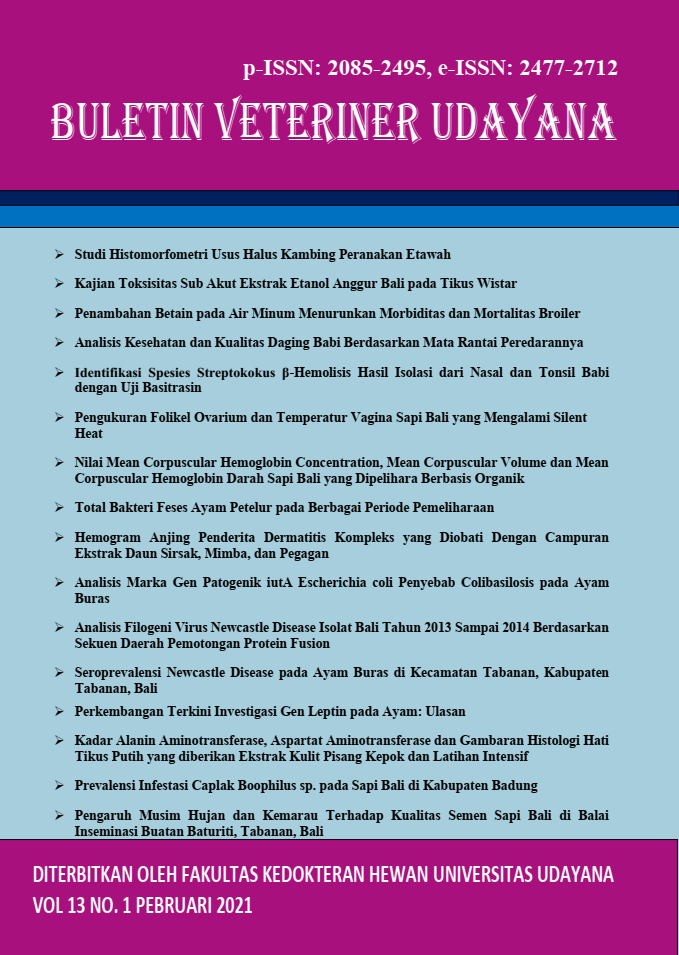MEASUREMENT OF OVARIAN FOLLICLES AND VAGINAL TEMPERATURE OF BALI CATTLE THAT EXPERIENCE SILENT HEAT
Abstract
This study aimed to improve Bali cattle's efficiency and productivity by measuring ovarian follicles and vaginal temperature in Bali cattle that experienced a silent heat using ten bali cattle with normal estrus and bali cattle that experience a silent heat. The research samples were divided into two groups: Bali cattle that showed normal estrus (grup I) and Bali cattle that experienced a silent heat (grup II), with each group consisted of 5 replications. Furthermore, all the cows were measured for vaginal measurements at the time of estrus and 24 hours after estrus. While ovarian follicles are measured at the time of estrus. The results showed that the average vaginal temperature of Bali cattle was 38.40 ± 0.130 C and 38.04 ± 0.130 C respectively for Bali estrus cattle and Bali cattle which experienced a silent heat and statistically showed a significant difference (P<0.05). The Bali cattle follicles' average diameter is 10.60 ± 1.14 and 7.32 ± 0.37 mm, respectively, for the normal estrus and which experience a silent heat, and statistically show a significant difference (P<0.05). From the results of the study, it can be concluded that the vaginal temperature of bali cattle with normal estrus is higher than that of bali cattle which experience a silent heat, and ovarian follicle diameter in normal estrus is greater than the diameter of the ovarian follicles of bali cattle that experience silent heat.
Downloads
References
Austin CR, Short RV.1990. The Ovary. Reproduction in mammals. 2ndEd. Cambridge University Press. Cambrige New York.
Bearden HJ, Fuquay J. 1992. Applied Animal Reproduction. Reston Publishing Company, Inc. A Prentice-Hall Company Reston, Virginia.
Fisher AD, Morton R, Dempsey JM, Henshall JM, Hill JR. 2008. Evaluation of a new approach for the estimation of the time of the LH surge in dairy cows using vaginal temperature and electrodeless conductivity measurements. Theriogenol. 70: 1065–1074.
Hafez ESE. 2000. Reproduction in Farm Animals. 7 th Ed. Lippincott William & Wilkins. A Wolter Kluwer Company.
Hovinen M, Silvonene J, Taponen S, Hanninen L, Pastell M, Aisla AM, Pyorala S. 2008. Detection clinical mastitis with the help of a thermal camera. J. Dairy Sci. 91: 4592-4598.
Indira PN, Kustono, Ismaya. 2014. The profil of vaginal temperature and cytology of vaginal smear in bali cattle during estrus cycle phase. J. Indonesian Trop. Anim. Agric. 39(3): 175-179.
Kyle BL, Kennedy AD, Small JA. 1998. Measurement of vaginal temperature by radioelementary for the prediction of estrus in beef cows. Theriogenol. 49: 1437-1449.
Laksmi DNDI, Trilaksana IGNB, Darmanta RJ, Darwan M, Bebas IW, Agustina KK. 2019. Correlation between body condition score and hormone level of Bali cattle with
postpartum anestrus. Indian J. Anim. Res. 53(12): 1599-1603.
López-Gatius F, Santolaria P, Mundet I, Yániz JL. 2005. Walking activity at estrus and subsequent fertility in dairy cows. Theriogenol. 63: 1419–1429.
McDonald, L.E., 2000. Veterinary Endocrinology and Reproduction. 3rd Ed. Bailliere Tindall, London.
McMillan KL. 2010. Recent advances in the synchronization of estrus and ovulation in dairy cows. J Reprod. 56(Suppl): S42–S47.
Sakatani M, Balboula AZ, Yamanaka K, Takahashi M. 2012. Effect of summer heat environment on body temperature, estrous cycles and blood antioxidant levels in Japanese Black cow. Anim Sci J. 83: 394–402.
Sakatani M, Takahashi M, Takenouchin N. 2016. The efficiency of vaginal temperature measurement for detection of estrus in Japanese Black cows. J. Reprod. Dev. 62(2): 201-207.
Vickers LA, Burfeind O, von Keyserlingk MAG, Veira DM, Weary DM, Heuwieser W. 2010. Technical note: Comparison of rectal and vaginal temperatures in lactating dairy cows. J Dairy Sci. 93: 5246–5251.





